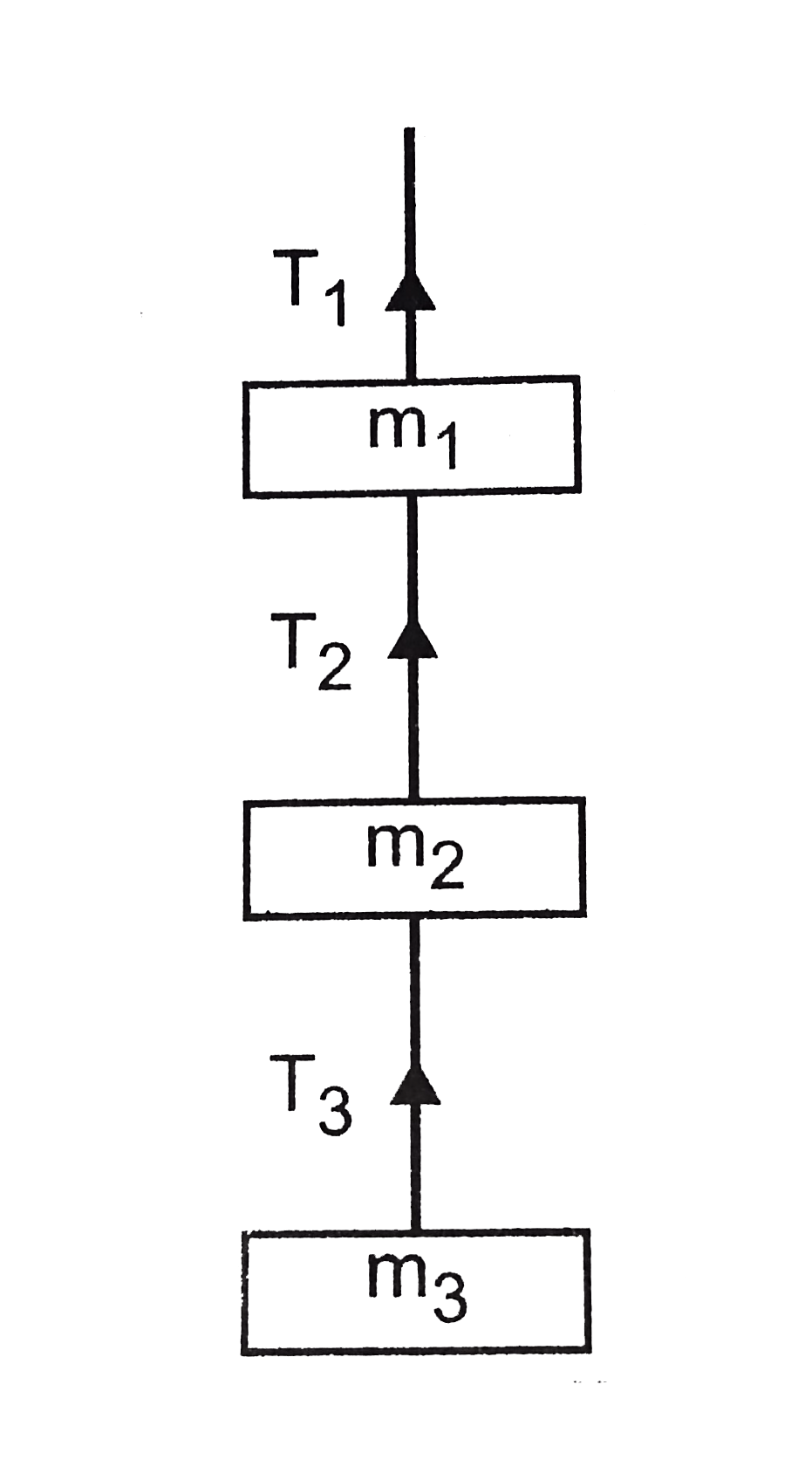The masses m1m2 and m3 of the three bodies shown in fig . Are 5 , 2 and 3 kg respectively Calculate the valuse of tension T1T2 and T3 when (i) the whole system is going upward with an acceleration of 2m/s2 (ii) the whole system is stationary (g=9.8m/s2) .
 .
.
Step by step video & image solution for The masses m_(1) m_(2) and m_(3) of the three bodies shown in fig . Are 5 , 2 and 3 kg respectively Calculate the valuse of tension T_(1) T_(2) and T_(3) when (i) the whole system is going upward with an acceleration of 2 m//s^(2) (ii) the whole system is stationary (g=9.8 m//s^(2)) . . by Physics experts to help you in doubts & scoring excellent marks in Class 11 exams.
Updated on:21/07/2023Topper's Solved these Questions
- LAWS OF MOTION : FRICTIONBook:SL ARORAChapter:LAWS OF MOTION : FRICTIONExercise:Problems
Explore 17 Videos
- LAWS OF MOTION : FRICTIONBook:SL ARORAChapter:LAWS OF MOTION : FRICTIONExercise:Self Practice
Explore 95 Videos
- Laws of MotionBook:SL ARORAChapter:Laws of MotionExercise:Exercise
Explore 627 Videos
- Mathematical toolsBook:SL ARORAChapter:Mathematical toolsExercise:Exercise
Explore 20 Videos
Similar Questions
A block of metal weighing 2kg is resting on a frictionless plane . It is struck by a jet of releasing water at the rate of 1kgs−1 and at a speed of 5ms−1 Calculate the intial acceleration of the blocks .
View SolutionA force acts for 10 s on a body of mass 10 kg after which the force ceases and the body describes 50 m in the next 5 s. Find the magnitude of the force.
View SolutionA force acts for 10 s on a body of mass 10 kg after which the force ceases and the body describes 50 m in the next 5 s. Find the magnitude of the force.
View SolutionFind dydx for the following functions:y=x3−3x2+3x−(25).
View SolutionThe masses m_(1) m_(2) and m_(3) of the three bodies shown in fig . Are 5 , 2 and 3 kg respectively Calculate the valuse of tension T_(1) T_(2) and T_(3) when (i) the whole system is going upward with an acceleration of 2 m//s^(2) (ii) the whole system is stationary (g=9.8 m//s^(2)) . .
View SolutionConsider three blocks of masses m_(1),m_(2),m_(3) interconnected by strings which are pulled by a common force F on a frictionless horizontal tabel as in the figure. The tension T_(1) and T_(2) are also indicated . a) T_(2)gtT_(1) if m_(2)gtm_(1) b) T_(2)=T_(1) if m_(2)=m_(1) , c) T_(2) gt T_(1) always d) acceleration of the system (F)/(m_(1)+m_(2)+m_(3)) .
View SolutionThree blocks are connected by strings as shown in and are pulled by a force T_(3)=60N if m_(1)=10 kg, m_(2)=20 kg and m_(3)=30 kg calculate the acceleration of the system and T_(1) and T_(2)
View SolutionThree blocks are connected as shown in the fig on a horizontal frictionless table if m_(1)=1kg, m_(2)=8kg, m_(3)=27 kg and T_(3)=36N, T_(2) will be:
View SolutionTwo masses m_(1) and m_(2) are accelerated uniformly on a frictionless surface as shown in figure given below. The ratio of the tensions T_(1)/T_(2) is:
View SolutionThree blocks are connected as shown in fig. on a horizontal frictionless table if m_(1)=1 kg, m_(2)=8kg, m_(3)=27kg and T_(3)=36N, T_(2) will be:-
View Solutionचित्र में T3=40 न्यूटन, m1=10 किग्रा, m2=6 किग्रा, m3=4 किग्रा, तब T2 का मान होगा -

View SolutionTwo objects A and B of masses m_(A) and m_(B) are attached by strings as shown in fig. If they are given upward acceleration then the rato of tension T_(1) : T_(2) is-
View SolutionThe masses M_(1), M_(2) and M_(3) are 5, 2 and 3 kg respectively. These have been joined using massless, inextensible pieces of strings as shown in the figure. If the whole system is going upward with an acceleration of 2ms^(-2) , then the value of tensions T_(1), T_(2) and T_(3) respectively are ["take "g=9.8ms^(-2)]
View SolutionThree blocks of masses m_(1), m_(2) and m_(3) are connected by a massless string as shown in figure on a frictionless table. They are pulled with a force T_(3) = 40N . If m_(1) = 10kg, m_(2) = 6kg and m_(3) = 4kg , then tension T_(2) will be
View SolutionConsider three blocks of masses m_(1), m_(2), m_(3) interconnected by strings which are pulled by a common force F on a frictionless horizontal table as in the figure. The tension T_(1) and T_(2) are also indicated a) T_(2) gt T_(1)" if "m_(2) gt m_(1) b) T_(2) =T_(1)" if "m_(2)=m_(1) c) T_(2) gt T_(1) always d) "acceleration of the system"=(F)/(m_(1)+m_(2)+m_(3))
View SolutionAs in the diagram three blocks connected together lie on a horizontal frictionless table and pulled to the right with a force F=50 N if m1=5kgm2=10 kg and m3=15kg find the tensions T1 and T2

View Solution
